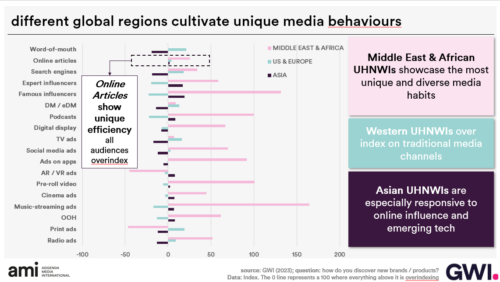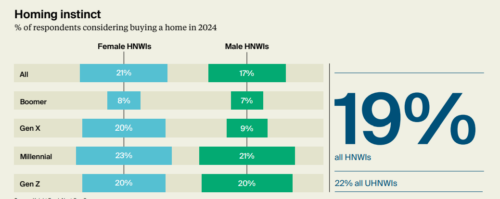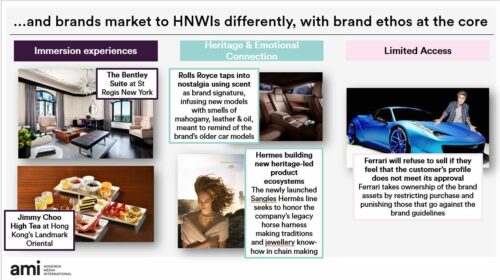Earlier this year we released a research report designed to help create better media campaigns targeting ultra high net worth individuals (UHNWI). Here we share 3 key principles for advertising to the world’s affluent, be it millionaires or billionaires. The report was designed with luxury property in mind, but findings can also be applied to other big investments where desire may not be the only driver to purchase to consider.
How the affluent differ from other target audiences
When defining a target audience, the first thing we turn to is demographics. Where is your audience based? Are they young or old? Are they a parent of 3, a senior citizen or a student? While demographics do not disclose everything, they are a trusty indicator of other behaviours, such as how these audiences spend their times, what their passions, cares and joys are. Then we combine this segmentation with an in-market behaviour, such as looking to move house, and voila – these are the people we need to get in front of.
Unfortunately, demographics do not provide a handy shortcut for audience definition when it comes to targeting the ultra-rich. While – rather paradoxically – we know exactly who these people are down to their names (just check the Forbes list), they are quite transient: UHNWI tend to be multiple passport holders, have multiple homes globally and means to travel to them at a moment’s notice. They are also a multi-generational audience. This is the only target group where a mining magnate from China and someone like Taylor Swift would be lumped together as having a profound connection.
In other words, UHNWI are truly individuals. They are impossible to put into neat demographic categories which direct marketers to the best media channels where this audience can be reached with minimum wastage.
1st principle: Be Where the Knowledge Is
So, what’s the solution? Reframe the definition. UHNWI are not united by who they are but by what they have. By having a common resource, they are pushed into certain behaviours related to taking care of it.
We see this in media research, too. Channel consumption patterns change based on an affluent person’s geographic location and age same as they do for all the other audiences. However, there is one uniting factor – UHNWI all over the world overindex for daily online article engagement and ad recall on this channel. This audience seeks out knowledge-based content that can direct them in their business and financial planning.
75% say that staying informed is their top priority and they are 220% more likely to be good networkers than a global average.

Similarly, UHNWIs’ other behaviours can also be explained by their financial status. They are:
- 40% more likely to be first to try new things, and even more likely to buy new products as soon as they appear
- 46% less likely to spend time scrolling on social media, presumably because money creates additional responsibilities and allows access to other activities
- 135% more likely to donate to charity regularly as financial excess allows for charitability to be a higher priority
Therefore, while UHNWI can be found on many media channels, you will be able to reach more of them with less wastage if you include high-value content environments.
2nd principle: Sell to the Invisible Circle of Influence
When it comes to decision making, UHNWI are not a single entity. So much so that I joke the name stands for “ultra high net worth incorporated”. According to IPSOS, 55% of the US affluent always consult a financial professional when making a financial decision, 19% of whom mostly rely on the recommendation from their advisor rather than making the decision themselves. And financial advisors are not the only ones that get to contribute: tax planners, estate planners, immigration attorneys and various inner circle members including family also have a say.
The advisors add another layer to the puzzle of demographics and behaviours, but what they have in common is the same interest in protecting the financial asset. Therefore – refer to the 1st principle – they can be found in environments that focus on sharing expertise and curate opinions.
Although united by the same goal, each contributor brings their personal motivations to the table. The balance between rational arguments and emotional communication that builds desire is individual to the situation of each luxury brand and its products. Both, however, need to be woven into the marketing timeline in order to resonate with the expanded circle of stakeholder.
3rd principle: Human Behaviours Prevail
Even though set apart by their business prowess, this audience is subject to the same human psychology as everyone else. It is no surprise, therefore, that life stages common to all such as going to university, starting work, starting a family, also impact UHNWIs’ likelihood to purchase.
For instance, Knight Frank Wealth Report has discovered that Gen Z and Millennial HNWI are more likely to be looking to buy property in 2024. The same trend applies to UHNWI, and this is due to their life stage – they are looking to get the first home(s) of their own. Meanwhile, Gen X and Boomer property enthusiasm is much lower due to priority being preparing their finances for retirement.

Same consideration applies to how UHNWI engage with media. To create effective campaigns, we need to apply the good old marketing best practice here too: focus on the quality of the format, its visibility, stickiness, perception and halo effect on the brand. Everyone has the same love for social media and the swamp-like numbness it brings to the brain after hard day of problem-solving. It does not, however, guarantee sufficient attention to deliver impact and it is not possible to accurately target UHNWI there too. Strategies like partnerships that enhance brand preference by prioritising experience and emphasis on desirability signals such as exclusivity can provide a higher certainty of reaching UHNWI.

Conclusion
There are no hard and fast rules for winning with UHNWI. The best-known luxury brands go through the same struggles and dedicate substantial marketing investment to appear in premium environments year in year out in order to form lasting associations and preference for their products. The other route – fame-based marketing – while strategically different, is equally tough on budgets and requires careful choreographing in order not to harm perceptions of exclusivity. There simply are no shortcuts to good strategy. However, having a framework can help stay on course and sift out the solutions that might look enticing but are less valuable to the business goals.


